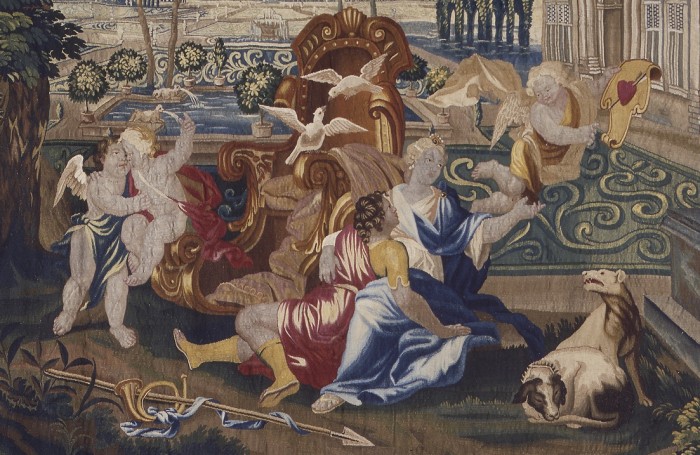Ingrid De Meûter, Curator of Tapestries and Textiles at the Brussels Jubelparkmuseum, has published Vlaamse wandtapijten- Productie en handel. De Oudenaardse familie Van Verren (1680-1740). The publication focuses on the production and trade of Flemish tapestries from the Oudenaarde region in the period 1680-1740. The publication is an extended and updated edition of De Meûter’s PhD dissertation. The author used commercial documents of the Van Verren family to provide new insights regarding the tapestry production in Oudenaarde.
Information from the author, 12 July 2016
New sources lead to attribution to production centres
The commercial documents of the Van Verren family in Oudenaarde were the point of departure of this research. They brought to light interesting new information that teaches us a lot about the production of tapestries in general. The in-depth research reveals a great deal about the customers’ wishes and trade practices at around the beginning of the 18th century.
Going through all the information and comparing it to the tapestries that have survived gives us a clearer picture of what was woven where in the Southern Netherlands during the transition from the 17th to the 18th century. Cross-contamination between production centres as Oudenaarde, Antwerp and Brussels can be revealed on several occasions.
Attribution of designs to cartoon painters
The study of the painters whose names appear in Van Verren’s documents makes it possible to attribute designs to Oudenaarde or other production centres. Only very little was known about most of the painters studied. Some of them are primarily or exclusively known for their work for the tapestry industry. On the basis of the documents and/or a comparison of the styles, various tapestry rooms were attributed to the painters studied. New attributions were made to the landscape painters Gaspard de Witte, Pieter Spierinckx and Augustin Coppens.
The customer always gets what he wants
The Van Verren family of entrepreneurs had a good nose for a good price/quality ratio. They were enormously flexible with regard to price and offered a wide range of variants. Firstly there were different choices in the painting of the patterns. As the painter of figures Lodewijk van Schoor wrote to his client Pieter van Verren in a letter, a painter could paint with different brushes. But apparently a merchant weaver could also adapt well to the customers’ requirements. The fact that different quality tapestries could be made from one and the same design is apparent from the difference in price of orders placed at the same time. The freedom to combine patterns was the most remarkable aspect of serving the customer as well as possible.
Vlaamse wandtapijten- Productie en handel. De Oudenaardse familie Van Verren (1680-1740).
Ingrid De Meûter, edited bij Provincie Oost-Vlaanderen
493 pp. ISBN: 9789074311939.
Summary in French and English and sub-titles in three languages
Available at museumshop@kmkg.be (Brigitte Fluyt) for €45.

